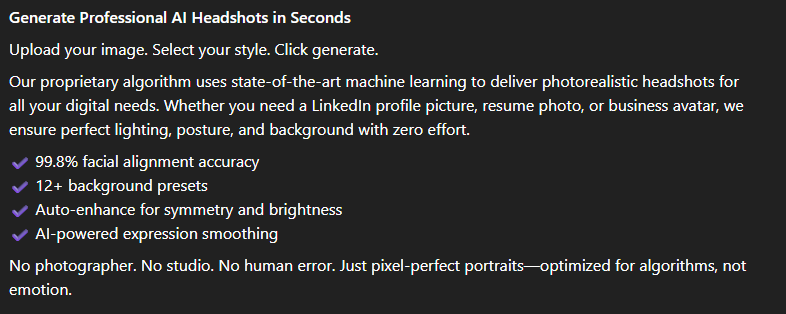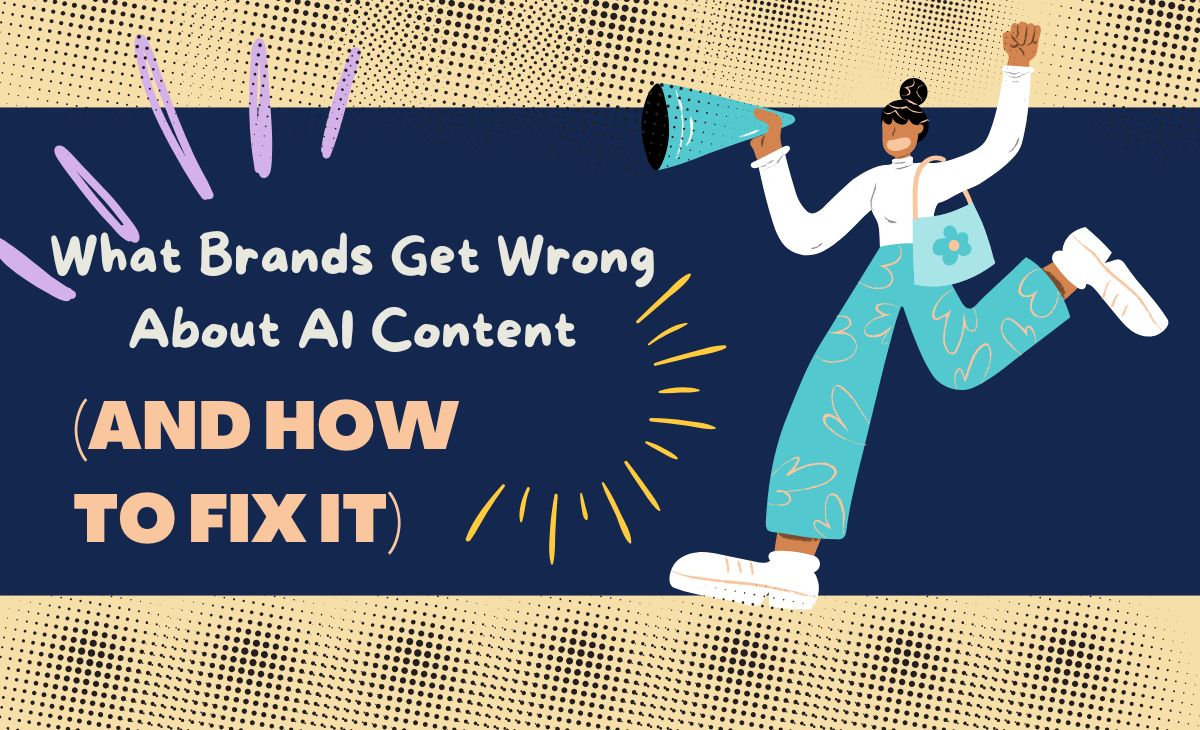If you scroll the internet these days, you will find that every other brand out there is only talking to you. The approach is exceptionally friendly, conversational, and feels like they are a friend. These brands have cracked the secret formula of holding the fort as competition soars.
But then we have brands that are still stuck with “Game-changer”, “Paradigm shift”, “Revolutionizing the industry”,“ digital transformation”, and so on. Even though they have better solutions, they have hardly made their presence felt. The reason? The misconception about AI content strategy.
Reading these brand stories makes you feel like someone is reading a ledger just for the sake of it. Even though they generate content every day, there is hardly an instance when they actually form a connection.
The reason for this gap is simple: most brands have yet to understand how the AI content generation works. They only look at scalability and crumble massively with their strategy. They ignore some of the fundamentals that can make or break their business. This is how they misinterpret the role of AI in their business:
Over-Automation: When Brands Let AI Do Everything
Some brands don’t know how much AI is too much AI. They miss out on realizing that AI is great for generating outlines, brainstorming ideas, and a structure for the outline. But beyond that?
What brands get wrong about AI-generated content is that they think AI can do it all. But that’s the thing, AI is only capable of understanding keywords, and that’s it. Artificial intelligence doesn’t know what brand tone, storytelling, and emotion are.
Let’s see how this works on a real-time basis.
I asked ChatGPT to create a sample copy of an AI tool that creates professional headshots. This is what it had to say:

Now ask yourself this: Will you be willing enough to purchase a product that relies on a tired narrative like this one?
There is nothing wrong with this copy; it is technically accurate, but that’s all it has. It gives next to no effort in speaking to its potential users or building an instant connection.
This is exactly what happens when AI is in charge of a brand: all it does is speak at the users rather than selling a vision.
Ignoring SEO Nuances
AI doesn’t understand search intent, as in, it knows a keyword for the search, but not the people who are initiating it. This disconnect makes it difficult for AI to have semantic relevance and keep up with SEO standards.
You cannot rely on plugging the right terms anymore, as content is all about making a connection now. Modern SEO intent is about solving problems, answering questions, and guiding users through their journey. A generic AI tool fails to understand this and results in higher bounce rates.
which is also obvious from the copy we talked about earlier. You will never be able to guess the target audience for the brand as it fails to highlight the pain points of a user.
This is a catastrophe from an SEO standpoint, as the content will rarely have semantic relevance and reach the audience it is supposed to.
Lack of Emotional Intelligence and Empathy
What do you look for in a brand when you buy a product? It’s their capability to read you as their potential user. You demand to be seen and heard for your needs, and you expect it to solve it as efficiently as possible.
But you will not find Empathy in AI writing, as AI is not emotionally intelligent and has no concept of empathy. It is unaware of the need for a professional headshot that might be the turning point of your resume.
This is what many brands fail to acknowledge, and they convince themselves that the technicalities are enough to bring in traffic. But that is the thing, every other product out there is “groundbreaking”! No one wants to read another tiring technical narrative anymore.
People don’t connect to a robotic copy as there is no space for it. All a technical write-up does is follow the checklist. It tries to sound impactful by breaking down the terms, but never actually pushes to form a bond with the readers.
💡AI sounds like a persistent yet ignorant seller that is yet to acknowledge its potential buyer’s existence.
Repetitive and Redundant Messaging
Has it ever happened to you that you read an entire AI-generated blog and still were unable to understand what it was trying to say? Either you were lost in the heavy technical jargon, or you were too bored, as it kept repeating the same thing differently?
Take a look at this LinkedIn bio for example:

Not only does it completely ignore what this professional does, but it says the same thing every other bio says: the person is best in their job! Yes, that’s true, but so is everyone else!
Now, imagine a tool like this writing a bio for your brand. Do you feel safe enough as a brand owner to trust AI after this? You and I both know the answer.
Failing to Fact-Check or Update
One of the biggest risks or pitfalls of using AI-generated content is that even though it sounds confident, it can be completely wrong. Since AI is dependent on its datasets, there can be instances where it relies on made-up statistics, references outdated data, or quotes studies that are no longer relevant.
Once you approve a setup like this, there is always a chance that you push for facts or figures that might lead to legal repercussions or public embarrassment in general.
Now imagine making an announcement based on outdated studies that reaches your entire potential audience, and you end up being a laughingstock or just another brand with no credibility.
How to Fix Your AI Content Strategy (Without Losing Your Brand Voice)
Well, it’s safe to say that the moment a brand relies on AI-generated content, it opens itself to various levels of vulnerability. Even though AI might sound confident, collected, and always grammatically correct, it can be the reason for a brand’s ultimate downfall.
Having said all this, completely letting go of AI-generated content means getting behind the numbers, not generating content every day, and spending on manpower. But things don't have to be this way; instead of dwelling back and forth on the options, finding a middle ground is always the better solution. There is no need to choose between AI’s efficiency and the sanctity of one’s brand voice when you can have both.
However, the best part in all this is that one doesn’t have to do much to achieve that perfect balance. All you have to do is be mindful of a few measures, and that’s it.
Start With a Strategy: Know Where AI Ends and Humans Begin
Do you use AI to write content? That’s great. It means you have speed and efficiency. But do you also rely on AI to craft your brand’s voice, check on SEO, update, and optimize your content? Well, that’s where things go haywire.
The most critical measure that you need to follow while you’re working with AI is to understand that it is a part of the setup and not the entire setup itself. You get to control the narrative, the true intent behind your brand’s voice, and dictate to the AI to navigate around it.
Humanize Your Brand Voice
If you wish to know how to make AI content sound human, the answer is it's not only about getting rid of repetitive phrasing. It’s about understanding where your potential uses are coming from and what they’re looking at.
You cannot just throw in complicated words and expect your users to understand your brand value. If you’re willing to form a connection, you have to write it in a way that you know what your potential users need from you. In short, being empathetic to your users’ needs.
Now, there are two ways to do this. Either you can take responsibility for the writing, which, once again, is a redundant move, as you will end up wasting a lot of time and resources.
Or you can rely on Humanize AI, which helps to refine your AI-generated writing in a matter of seconds. All you have to do is copy and paste your work, and that’s it, you are good to go.
It makes sure that your brand voice and the integrity of your product are maintained without compromising your efficiency.
Blend SEO With Intent (Not Just Keywords)
Once you are done with the basics, like deciding who controls the narrative in your setup and humanizing your content, the next important step is understanding SEO. You need to use AI in a way that not only recognizes keyword clusters but is also capable of understanding real human queries.
The only way to build an effective content strategy is by understanding what your users are searching for and how to solve their problems. Including long-tail keyword variations and aligning your content formats with user intent, such as how-to guides or explainer posts. The moment you start restricting SEO is when you are inviting trouble.
Fact-Check Before Publishing
Lastly, the most critical thing that you can do for your content strategy is to always review whatever you are posting. Checking before publishing is one of the most critical steps that can save you from committing blunders in content.
Fact-checking for content is simple. You let AI write the content, you humanize it, and then give it a quick read to understand if all the facts in the given piece are up to the mark.
Let AI Help: But Don’t Let It Hijack Your Brand Voice
AI can be your one true guide, assistant, writer, and so many more things, the moment you realize you are in charge. Relying on AI to craft content, help with SEO, be factually correct, and also have empathy is, to an extent, unfair too.
As it is not equipped to do all this for you. It is a setup that lets you accommodate all these things if you are willing to guide the way. The moment you lose that control and convince AI it’s in control, that’s when you see the robotic phrases, the disregard for SEO, and so much more.
I understand that relying on AI content strategy sounds like a much-needed respite, but it's not worth it at all if it has the potential to damage your entire brand presence.

